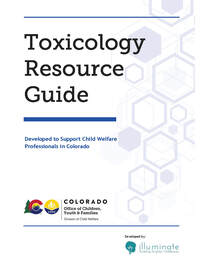Common Signs and Symptoms of Toxicity (Toxidromes) of Substance
Sedative/Hypnotic Toxidrome
- Example substances: alcohol, benzodiazepines, some muscle relaxants, barbiturates, anti-seizure medications
- Symptoms: sedation (sleepiness), coma, bradypnea (slow breathing), hypotension (low blood pressure), ataxia (unbalanced), nystagmus (shaky eyes), slurred speech
Sympathomimetric Toxidrome
- Example substances: amphetamines, methamphetamines, cocaine, synthetic cannabinoids (k2, spice, etc), synthetic cathinones (bath salts, etc), stimulants
- Symptoms: anxiety, agitation, diaphoresis (sweaty), psychosis, delusions, mydriasis (large pupils), tachycardia (fast heart rate), tachypnea (fast breathing), hypertension (high blood pressure), pressured speech
Opioid Toxidrome
- Example substances: oxycodone, heroin, fentanyl, hydrocodone, methadone, etc.
- Symptoms: sedation, coma, miosis (small pupils), bradypnea (slow breathing), hypotension (low blood pressure), slurred speech
Hallucinogenic Toxidrome
- Example substances: MDMA (ecstasy), LSD, peyote, PCP, ketamine, dextromethorphan, psilocybin mushrooms
- Symptoms: hallucinations, delusions, psychosis, altered mental status, agitation, nystagmus (shaky eyes), tachycardia (fast heart rate), tachypnea (fast breathing), hypertension (high blood pressure), slurred speech
Cannabis
- Examples: traditional buds, concentrations which include dabs, budders, waxes, and edible products using different strains of the cannabis plant, including THC and CBD
- Symptoms: There is no typical presentation for marijuana intoxication. It can consist of the more classic symptoms of sleepiness, slowed reaction times, mydriasis (dilated pupils), injected eyes, but can also include more anxiety, paranoia, psychosis, and agitation. In young children, symptoms can be prolonged and more severe including breathing difficulties, ataxia (unbalanced), and rarely, coma.

When considering how a substance may or may not be affecting care or safety of a child, these signs and symptoms can be helpful in knowing what questions to ask children, parents and caregivers, and other support people involved in a family’s life.
For example, alcohol, marijuana, and prescription medications while legal substances, still may be cause for concern if caregivers aren’t able to discern when it’s safe for them to drive a car. On the other hand, families often know their members best and may already have a plan that a grandparent picks up and drives the children to and from childcare when necessary.
Talk with caregivers about environmental safety concerns, such as safe storage of substances in the home or on the property - including alcohol, prescription medications, cannabis products, other drugs, and paraphernalia, as well as household cleaners, fertilizers, and other hazardous materials.
It’s important to determine what impact a substance may have, and if a family is already aware of and controlling for this on their own.
For example, alcohol, marijuana, and prescription medications while legal substances, still may be cause for concern if caregivers aren’t able to discern when it’s safe for them to drive a car. On the other hand, families often know their members best and may already have a plan that a grandparent picks up and drives the children to and from childcare when necessary.
Talk with caregivers about environmental safety concerns, such as safe storage of substances in the home or on the property - including alcohol, prescription medications, cannabis products, other drugs, and paraphernalia, as well as household cleaners, fertilizers, and other hazardous materials.
It’s important to determine what impact a substance may have, and if a family is already aware of and controlling for this on their own.
SEDATIVE/HYPNOTIC TOXIDROME (CENTRAL NERVOUS SYSTEM DEPRESSANTS)
ALCOHOL, BENZODIAZEPINES (DIAZEPAM, ALPRAZOLAM), MUSCLE RELAXANTS (CYCLOBENZAPRINE, BACLOFEN), ETC.
ALCOHOL, BENZODIAZEPINES (DIAZEPAM, ALPRAZOLAM), MUSCLE RELAXANTS (CYCLOBENZAPRINE, BACLOFEN), ETC.
|
|
SYMPATHOMIMETIC TOXIDROME (CENTRAL NERVOUS SYSTEM STIMULANTS)
COCAINE, METHAMPHETAMINE, CAFFEINE, METHYLPHENIDATE
COCAINE, METHAMPHETAMINE, CAFFEINE, METHYLPHENIDATE
|
|
HALLUCINOGENS
MDMA/ECSTASY, SALVIA, PEYOTE, PSILOCYBIN/MUSHROOMS, DEXTROMETHORPHANE, KETAMINE
MDMA/ECSTASY, SALVIA, PEYOTE, PSILOCYBIN/MUSHROOMS, DEXTROMETHORPHANE, KETAMINE
|
|
OPIOID TOXIDROME
HEROIN, FENTANYL, OXYCODONE, HYDROCODONE, MORPHIN
HEROIN, FENTANYL, OXYCODONE, HYDROCODONE, MORPHIN
|
|

While all of this toxicology information is informative and helpful for assessment, the Colorado Family Safety Assessment Tool is a tool to be used with a family to help guide your practice to identify current or impending danger, risk, strengths and protective capacities.
Using substances in and of itself is not necessarily a child welfare concern. This is why it’s so important to put your critical thinking skills to the test! The Colorado Family Safety Assessment tool helps us to remember to do a complete assessment to see what’s working and what’s not in each unique household.
This Toxicology Resource Guide can help you to know what to ask and why, as well as when different types of drug screens might be most effective. It can also help you think through potential complications in order to help a family be most successful in writing a manageable safety or support plan.
Using substances in and of itself is not necessarily a child welfare concern. This is why it’s so important to put your critical thinking skills to the test! The Colorado Family Safety Assessment tool helps us to remember to do a complete assessment to see what’s working and what’s not in each unique household.
This Toxicology Resource Guide can help you to know what to ask and why, as well as when different types of drug screens might be most effective. It can also help you think through potential complications in order to help a family be most successful in writing a manageable safety or support plan.

